Vienna, Austria
October 2, 2024
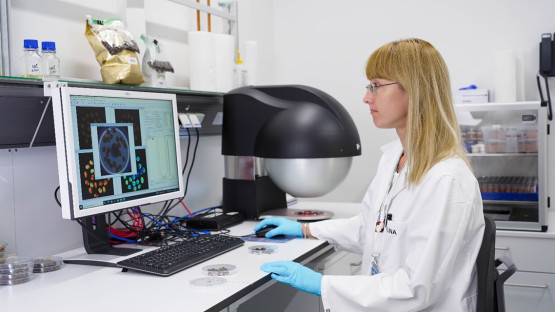 A scientist in the FAO/IAEA Food Safety and Control Laboratory performing tests utilizing mass spectrometry imaging (MSI) to detect economically motivated adulteration of Arabica coffee beans. This analytical technique can help prevent food fraud in coffee. (Photo: M. Casling/IAEA)
A scientist in the FAO/IAEA Food Safety and Control Laboratory performing tests utilizing mass spectrometry imaging (MSI) to detect economically motivated adulteration of Arabica coffee beans. This analytical technique can help prevent food fraud in coffee. (Photo: M. Casling/IAEA)
This October, the Joint FAO/IAEA Centre of Nuclear Techniques in Food and Agriculture is celebrating a remarkable milestone — its 60th anniversary. Established in 1964, this partnership between the Food and Agriculture Organization (FAO) of the United Nations and the IAEA has advanced the use of nuclear science to boost food security, agricultural productivity and environmental sustainability.
Over the past six decades, the Joint FAO/IAEA Centre has harnessed nuclear technologies to support countries in tackling critical global challenges, from increasing crop yields and protecting livestock to controlling pests, advancing soil and water management and safeguarding food safety and authenticity.
The FAO/IAEA Biotechnology laboratories have been a central part of the Joint FAO/IAEA Centre’s work since its establishment. These state-of-the-art laboratories are the backbone of the Joint FAO/IAEA Centre’s operations, focusing on the development of technologies to help address agricultural and environmental challenges. Today, the laboratories remain at the forefront of science, technology and innovation, continuing to provide essential research, capacity development and technology transfer to countries.
Six Decades of Advancing Nuclear Science for Food and Nutrition Security
Since its establishment, the Joint FAO/IAEA Centre has provided significant contributions towards the improvement of agrifood systems through the application of nuclear science and nuclear-related techniques in five key working areas:
Insect Pest Control
The Joint FAO/IAEA Centre actively advances the development and application of the Sterile Insect Technique (SIT) and other radiation-based pest management technologies. Since the Joint FAO/IAEA Centre’s infancy, SIT has been one of its core functions, allowing it to effectively control insect pests while reducing or eliminating reliance on chemical pesticides. By using SIT, male insects of targeted species can be sterilised by using ionizing radiation. In Fort Myers, Florida in the United States of America, SIT is being used to suppress mosquitoes that have become resistance to insecticides.
In 2024, SIT played a key role in eradicating the Medfly from the Dominican Republic, after a resurgence since the first eradication in 2017. SIT has been instrumental in helping the country to regain access to important export markets.
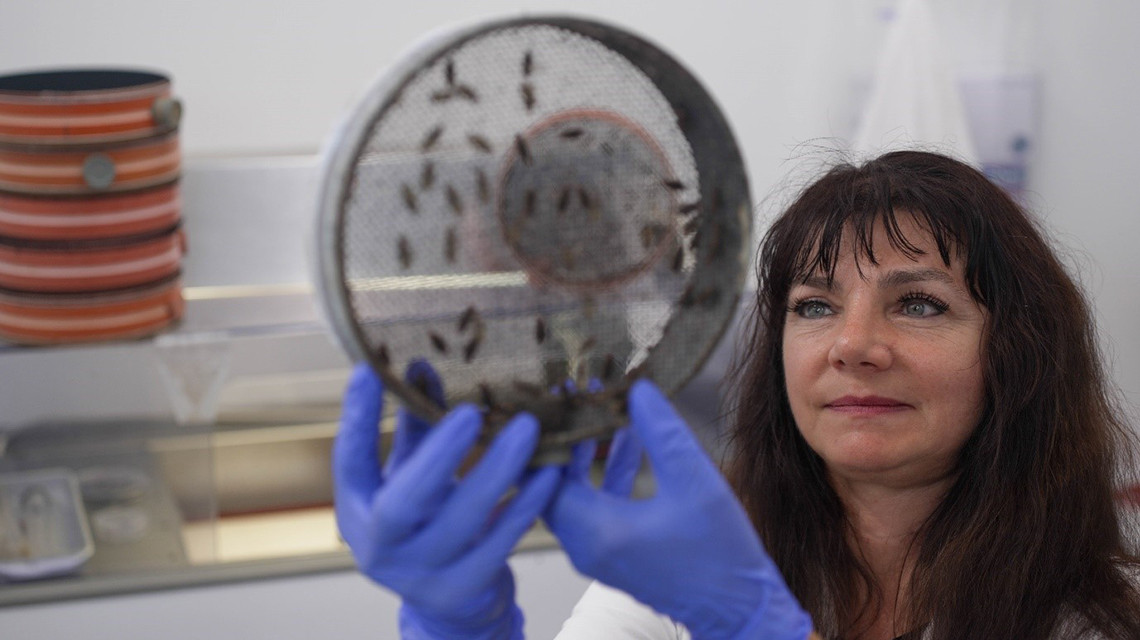 A scientist rearing Tsetse flies in the FAO/IAEA Insect Pest Control Laboratory. (Photo: M. Casling/FAO/IAEA)
A scientist rearing Tsetse flies in the FAO/IAEA Insect Pest Control Laboratory. (Photo: M. Casling/FAO/IAEA)
Plant Breeding and Genetics
One key component of the Joint FAO/IAEA Centre is the advancement of mutation breeding to generate plants that demonstrate improved traits. This technique involves the irradiation of plant seeds and other plant materials to accelerate the natural mutation process, leading to the development of desirable genetic variations that enhance agricultural productivity.
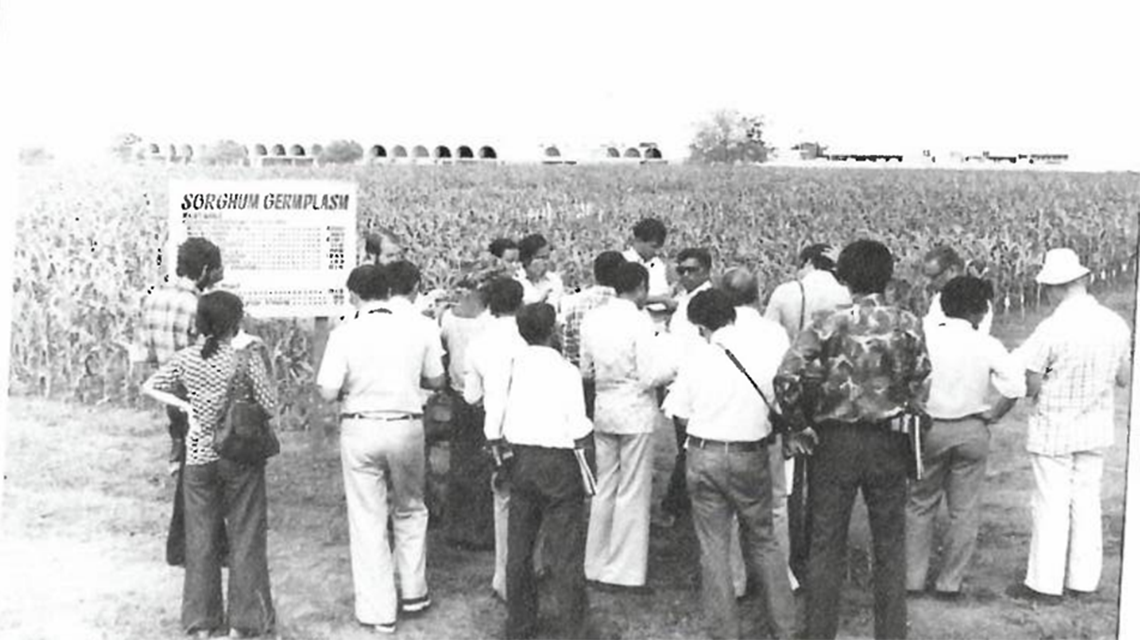 Plant breeders from the Joint FAO/IAEA Centre and India analysing a Sorghum field in India, circa 1978. (Photo: A. Meike/IAEA)
Plant breeders from the Joint FAO/IAEA Centre and India analysing a Sorghum field in India, circa 1978. (Photo: A. Meike/IAEA)
To support collaboration between countries and knowledge-sharing, the Joint FAO/IAEA Centre maintains the FAO/IAEA Mutant Variety Database (MVD), a comprehensive repository for information on officially released mutant crop varieties. As of 2024, the database holds records of 3433 improved mutant varieties released globally, covering over 200 plant species.
In 2022, the Joint FAO/IAEA Centre sent seeds to the International Space Station to explore the effects of cosmic radiation and microgravity on plant genetics. Scientists are now analysing space-induced mutations to identify traits that could make crops more resilient to climate change.
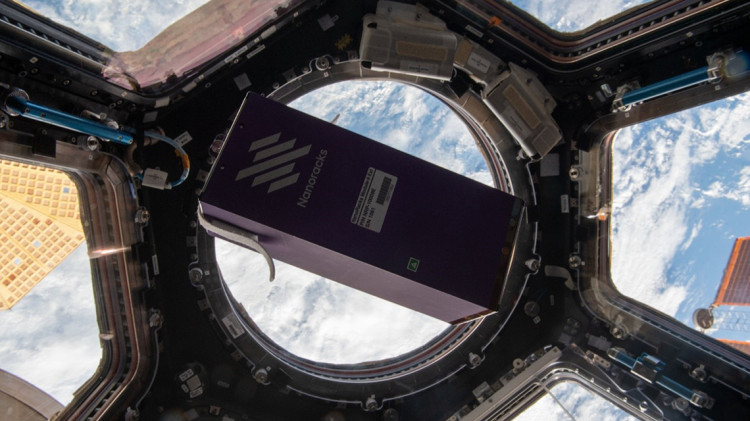 Seeds from the IAEA and FAO laboratories were sent to space on November 7, 2022. (Photo: NASA)
Seeds from the IAEA and FAO laboratories were sent to space on November 7, 2022. (Photo: NASA)
Soil and Water Management and Crop Nutrition
Nuclear and isotopic techniques provide valuable tools for quantifying and improving soil fertility and crop nutrition. The Joint Centre develops and transfers solutions to monitor and manage the interactions between water, soil and nutrients, enhancing the productivity and sustainability of cropping systems. In addition, it also leads efforts to tackle soil contamination and its remediation, addressing challenges such as heavy metals, antimicrobial resistance, microplastics and radioactive contaminants.
Utilizing nitrogen-15 isotopic techniques, the Joint FAO/IAEA Centre trained local researchers and farmers in Lao People's Democratic Republic to optimize fertilizer use while effectively incorporating rice straw and manure as nutrient sources. Field trials conducted on local farms demonstrated substantial increases in rice yields, bolstering food security in a nation that heavily relies on rainfall-dependent rice cultivation. This initiative not only improved agricultural productivity but also promoted sustainable practices that are crucial for the resilience of the agricultural sector in the country.
 A Cosmic Ray Neutron Sensor (CRNS) as seen in the background, sharing real-time soil moisture content data to the phone in the foreground. (Photo: M. Casling/IAEA)
A Cosmic Ray Neutron Sensor (CRNS) as seen in the background, sharing real-time soil moisture content data to the phone in the foreground. (Photo: M. Casling/IAEA)
Tools such as the Cosmic Ray Neutron Sensor (CRNS) are changing how water resources can be managed by providing precise data on soil moisture levels. By measuring the naturally occurring neutrons in the soil, the CRNS offers precise, real-time and large-scale monitoring of moisture content.
Animal Production and Health
The Joint FAO/IAEA Centre plays a vital role in improving animal production and health by applying nuclear and related techniques. Its work has driven improvements in livestock productivity, feed efficiency, and the diagnosis and control of animal diseases, leading to safer and more efficient livestock systems.
In August 2020, with support from the Joint FAO/IAEA Centre, laboratories in Bosnia Herzegovina and Serbia successfully utilized genome sequencing to characterize the COVID-19 virus. This capability, built upon real-time RT-PCR techniques, enabled researchers to trace the origins of the virus and analyse transmission patterns. The veterinary laboratories were particularly well-prepared due to their experience with zoonotic diseases, allowing for effective intervention planning and the sharing of crucial data on virus mutations.
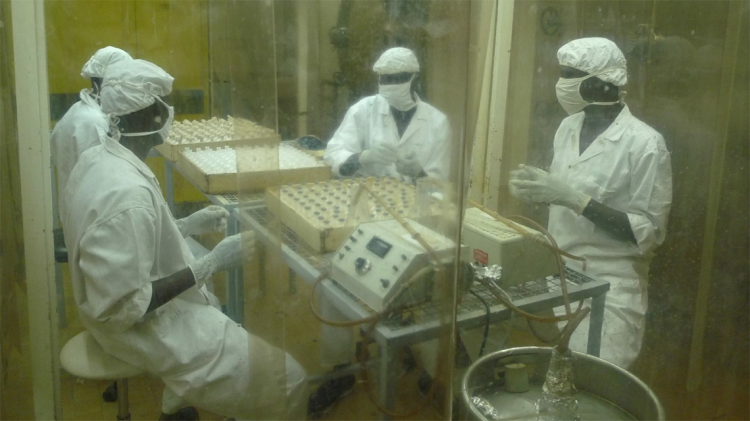 Scientists supported by the Joint FAO/IAEA Centre preparing irradiated vaccines for animals. (Photo: IAEA)
Scientists supported by the Joint FAO/IAEA Centre preparing irradiated vaccines for animals. (Photo: IAEA)
To tackle transboundary animal and zoonotic diseases, the Joint FAO/IAEA Centre’s VETLAB Network strengthens veterinary laboratory diagnostic capacities across countries, particularly in Africa and Asia. The VETLAB Network facilitates sharing expertise, training, and information among national animal disease diagnostic laboratories. It enhances preparedness and response to animal and zoonotic disease outbreaks by harmonizing regional approaches to early detection and disease alerts.
Food Safety and Control
The IAEA and FAO assist countries in in combating food fraud, detecting harmful contaminants and ensuring the authenticity and quality of food products.
For example, Viet Nam has significantly increased its food exports through food irradiation, which effectively prevents the spread of transboundary pests and eliminates microorganisms that could spoil the food, ensuring that consumers receive safe products.
An example of the Joint FAO/IAEA Centre’s efforts to enhance food safety can be seen in Sri Lanka, where since 2001, its assistance has helped the Food Safety and Quality Assurance Laboratory (FSQAL) develop advanced testing capabilities to detect aflatoxins, a dangerous contaminant produced by fungi on crops like corn and peanuts. With nuclear techniques, food products are monitored for aflatoxin contamination, playing a key role in shaping national food safety regulations and ensuring that contaminated food does not reach the market, protecting both local and international consumers from potential health risks like cancer.
An example of the Joint FAO/IAEA Centre’s effort to enhance food safety can be seen in Bangladesh, where its assistance to the Veterinary Drug Residue Analysis Laboratory (VDRAL) trained VDRAL scientists on how to test for a range of food hazards and to screen and verify residues and contaminants in food. VDRAL now uses different isotopic and nuclear-based analytical tools and techniques for the determination of antimicrobial residues and mycotoxins in foods of animal and plant origin, and efforts are also under way to build capacity for food microbiological testing, including aspects of food-borne zoonoses. With the Joint FAO/IAEA Centre’s support, more than 3000 food samples, including eggs, milk, chicken and shrimp, are analysed annually to generate residue data.
In the effort to curb food fraud, the Joint FAO/IAEA Centre develops and transfers nuclear techniques to detect fraudulent food. For example, scientists from the Jozef Stefan Institute in Slovenia, supported by the joint FAO/IAEA Centre, employed isotopic analysis to identify fraudulent white truffles. This method helps determine their origins and prevent food fraud effectively.
Celebrating 60 Years of Innovation and Collaboration
As the Joint FAO/IAEA Centre marks its 60th anniversary, it reflects on a legacy of innovation and collaboration that underscores the critical role of science and international cooperation in tackling global challenges in agrifood systems transformation. The Joint FAO/IAEA Centre is dedicated to developing solutions to promote access to nutritious and safe food for a growing population while minimizing agriculture's environmental impacts and addressing climate change threats.
To help boost global food production and food and nutrition, the IAEA and FAO launched the Atoms4Food initiative in 2023 during the World Food Forum. It offers tailor-made approaches in food and agriculture. The initiative supports countries in using innovative nuclear techniques to enhance agricultural productivity, increase the resilience of agrifood systems, enhance food production, improve food safety, and the challenges of climate change.
The Joint FAO/IAEA Centre will continue to drive innovation and deliver tangible solutions to the ever-changing agricultural challenges facing our world by fostering research for development, enhancing capacity development and knowledge sharing, and strengthening partnerships.